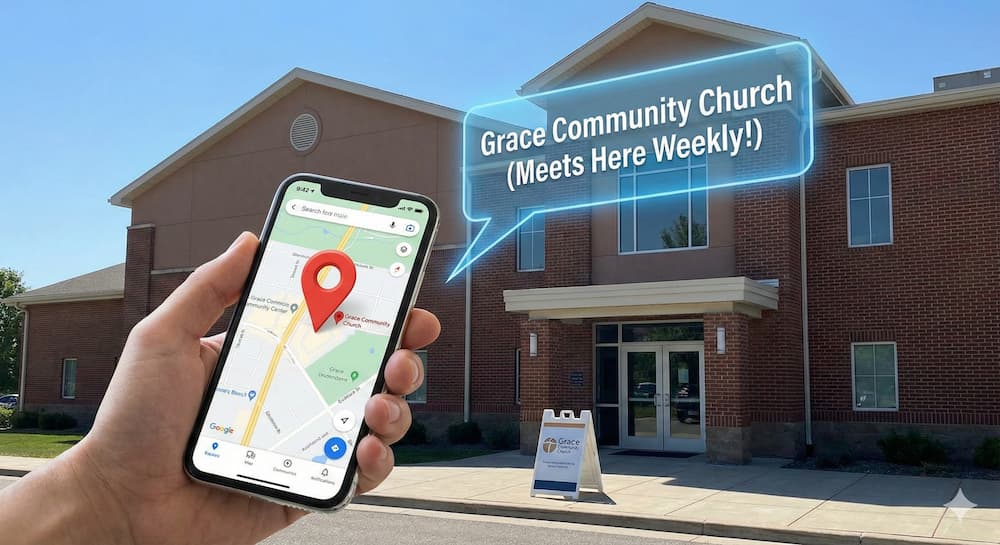Your Church Font Matters More Than You Know: 7 Best Practices for Church Fonts
Craft a cutting-edge church brand by implementing these 7 critical font principles.

Controversial opinion:
Your church fonts are the most important decision in your church design.
Hear me out.
If you have an amazing church logo, but you use Comic Sans, your church will look unprofessional.
That’s why most churches outsize their church name in their design.
There is a branding reason for this. When people talk about your church, they don’t say, “Have you heard of [cool logo] church?” No. They say, “Have you heard of Holy Trinity on 146th?” People see your name. People remember your name.
And when people remember your name, they remember it in the font in which you choose to display it.
Try this experiment:
I’m going to say a brand name, and I want you to be honest about what comes to mind first.
- Coca-Cola
- McDonald’s
- adidas
- VISA
- LEGO
- GAP
All of these names are visualized as fonts.
Your church is no different.
In fact, that fonts you choose for your church website work the exact same way on a more subliminal level.
The fonts you use on your website should not only directly correspond to your church logo font choice, but you should also strategically choose the right fonts. Thankfully, there are rules and best practices to help guide you to make the best decision for your church so that your website visitors are more like to visit and to engage.
Here are seven tips to choose the right fonts to create an unforgettable church logo and website.
1. Stick to a main headline font and a main body copy font
In other words, don't use a bunch of different fonts.
Choose a primary font that you use for all of you main headlines, and choose another primary font that you use for all of your paragraph font.
When you add third and fourth fonts, your website will begin to look unsightly. It will seem “off” to the people reading it.
This even applies to pictures of font, which is why the font you use in your church signage should look as close as possible to the font on your website. In short, when you show pictures of your church on your website, it will look uniform with your site, and the pictures will be more pleasant to view for your website visitors.
2. Connect your fonts to the "brand" of your church
What is the culture of your church? What feeling do you want people to have when they see your font?
Do you want your church website font to be sophisticated? Playful? Modern? Whatever font you choose will communicate something about the feeling of your church.
There is a difference between a serif font and a sans serif font. A serif font will have little lines hanging off the edges of each letter, and a sans serif font will have clean, single lines that are more simple.
Serif fonts tend to communicate something more intellectual. Sans serif fonts tend to communicate straightforwardness.
Thick font often communicates an emphasis and importance. Thinner fonts communicate elegance, modernity, and sophistication.
3. Use Google Fonts
If you don’t have the budget to purchase a fully licensed premium font for your church website, you can use Google Fonts (most web providers supply access to Google Fonts), which gives you access to almost 1,000 free fonts, which include web-optimized fonts.
4. Don’t use a font-constrained platform
Use a website platform that enables you to easily choose from a variety of great fonts so you don't have to embed them, install them, or manually code them into your website.
Tithe.ly Sites comes built-in with a curated list of great Google Fonts, and we are always adding more great options.
5. Make sure your font is readable in both big and small contexts
This is one of the biggest mistakes churches make when choosing a font. They choose font configurations that aren’t readable in every format.
If your church font is too thin, it might not work on smaller printables like business cards.
If your font is too big, it might look too bulky and overbearing on a 100” projector screen during the service.
Make sure to test your font in a variety of venues—big and small, digital and print—to ensure that your font isn’t unreadable in important formats.
6. Use complementary font weights
Most fonts have multiple weights that range from very thin to very bold—premium fonts sometimes have up to 10-12 levels.
Ideally, across all your designs, you should pick two fonts that are no more than 200 points away from each other—in other words, two levels of thickness apart.
Here’s another way to put it:
Don’t choose the boldest font for your headline and the thinnest font for your paragraph font, or vice versa.
7. Consult a designer to help you pick an appropriate font
Choosing the right font is a big decision.
It is very worth your time to find a designer in your church—or a local designer with whom you can consult—to help you pick the right fonts.
Since this is a one-time consultation, this shouldn’t be too expensive. But the return on investment for your church could last for years.
It’s very worth investing a couple hundred dollars to get a professional designer to help guide you through a process that will have a lasting impact on the way visitors and members alike will experience your church.
Conclusion
Whatever church font you choose, if it’s part of your church logo or any print assets, you may be stuck with it for a while.
Make sure to invest the appropriate amount of time and consideration into this decision.
It sounds like a small and insignificant decision, but your font is likely the first thing every new visitor will notice when they hear about, see, or read about your church.
Sign Up for Product Updates
Controversial opinion:
Your church fonts are the most important decision in your church design.
Hear me out.
If you have an amazing church logo, but you use Comic Sans, your church will look unprofessional.
That’s why most churches outsize their church name in their design.
There is a branding reason for this. When people talk about your church, they don’t say, “Have you heard of [cool logo] church?” No. They say, “Have you heard of Holy Trinity on 146th?” People see your name. People remember your name.
And when people remember your name, they remember it in the font in which you choose to display it.
Try this experiment:
I’m going to say a brand name, and I want you to be honest about what comes to mind first.
- Coca-Cola
- McDonald’s
- adidas
- VISA
- LEGO
- GAP
All of these names are visualized as fonts.
Your church is no different.
In fact, that fonts you choose for your church website work the exact same way on a more subliminal level.
The fonts you use on your website should not only directly correspond to your church logo font choice, but you should also strategically choose the right fonts. Thankfully, there are rules and best practices to help guide you to make the best decision for your church so that your website visitors are more like to visit and to engage.
Here are seven tips to choose the right fonts to create an unforgettable church logo and website.
1. Stick to a main headline font and a main body copy font
In other words, don't use a bunch of different fonts.
Choose a primary font that you use for all of you main headlines, and choose another primary font that you use for all of your paragraph font.
When you add third and fourth fonts, your website will begin to look unsightly. It will seem “off” to the people reading it.
This even applies to pictures of font, which is why the font you use in your church signage should look as close as possible to the font on your website. In short, when you show pictures of your church on your website, it will look uniform with your site, and the pictures will be more pleasant to view for your website visitors.
2. Connect your fonts to the "brand" of your church
What is the culture of your church? What feeling do you want people to have when they see your font?
Do you want your church website font to be sophisticated? Playful? Modern? Whatever font you choose will communicate something about the feeling of your church.
There is a difference between a serif font and a sans serif font. A serif font will have little lines hanging off the edges of each letter, and a sans serif font will have clean, single lines that are more simple.
Serif fonts tend to communicate something more intellectual. Sans serif fonts tend to communicate straightforwardness.
Thick font often communicates an emphasis and importance. Thinner fonts communicate elegance, modernity, and sophistication.
3. Use Google Fonts
If you don’t have the budget to purchase a fully licensed premium font for your church website, you can use Google Fonts (most web providers supply access to Google Fonts), which gives you access to almost 1,000 free fonts, which include web-optimized fonts.
4. Don’t use a font-constrained platform
Use a website platform that enables you to easily choose from a variety of great fonts so you don't have to embed them, install them, or manually code them into your website.
Tithe.ly Sites comes built-in with a curated list of great Google Fonts, and we are always adding more great options.
5. Make sure your font is readable in both big and small contexts
This is one of the biggest mistakes churches make when choosing a font. They choose font configurations that aren’t readable in every format.
If your church font is too thin, it might not work on smaller printables like business cards.
If your font is too big, it might look too bulky and overbearing on a 100” projector screen during the service.
Make sure to test your font in a variety of venues—big and small, digital and print—to ensure that your font isn’t unreadable in important formats.
6. Use complementary font weights
Most fonts have multiple weights that range from very thin to very bold—premium fonts sometimes have up to 10-12 levels.
Ideally, across all your designs, you should pick two fonts that are no more than 200 points away from each other—in other words, two levels of thickness apart.
Here’s another way to put it:
Don’t choose the boldest font for your headline and the thinnest font for your paragraph font, or vice versa.
7. Consult a designer to help you pick an appropriate font
Choosing the right font is a big decision.
It is very worth your time to find a designer in your church—or a local designer with whom you can consult—to help you pick the right fonts.
Since this is a one-time consultation, this shouldn’t be too expensive. But the return on investment for your church could last for years.
It’s very worth investing a couple hundred dollars to get a professional designer to help guide you through a process that will have a lasting impact on the way visitors and members alike will experience your church.
Conclusion
Whatever church font you choose, if it’s part of your church logo or any print assets, you may be stuck with it for a while.
Make sure to invest the appropriate amount of time and consideration into this decision.
It sounds like a small and insignificant decision, but your font is likely the first thing every new visitor will notice when they hear about, see, or read about your church.
podcast transcript
Controversial opinion:
Your church fonts are the most important decision in your church design.
Hear me out.
If you have an amazing church logo, but you use Comic Sans, your church will look unprofessional.
That’s why most churches outsize their church name in their design.
There is a branding reason for this. When people talk about your church, they don’t say, “Have you heard of [cool logo] church?” No. They say, “Have you heard of Holy Trinity on 146th?” People see your name. People remember your name.
And when people remember your name, they remember it in the font in which you choose to display it.
Try this experiment:
I’m going to say a brand name, and I want you to be honest about what comes to mind first.
- Coca-Cola
- McDonald’s
- adidas
- VISA
- LEGO
- GAP
All of these names are visualized as fonts.
Your church is no different.
In fact, that fonts you choose for your church website work the exact same way on a more subliminal level.
The fonts you use on your website should not only directly correspond to your church logo font choice, but you should also strategically choose the right fonts. Thankfully, there are rules and best practices to help guide you to make the best decision for your church so that your website visitors are more like to visit and to engage.
Here are seven tips to choose the right fonts to create an unforgettable church logo and website.
1. Stick to a main headline font and a main body copy font
In other words, don't use a bunch of different fonts.
Choose a primary font that you use for all of you main headlines, and choose another primary font that you use for all of your paragraph font.
When you add third and fourth fonts, your website will begin to look unsightly. It will seem “off” to the people reading it.
This even applies to pictures of font, which is why the font you use in your church signage should look as close as possible to the font on your website. In short, when you show pictures of your church on your website, it will look uniform with your site, and the pictures will be more pleasant to view for your website visitors.
2. Connect your fonts to the "brand" of your church
What is the culture of your church? What feeling do you want people to have when they see your font?
Do you want your church website font to be sophisticated? Playful? Modern? Whatever font you choose will communicate something about the feeling of your church.
There is a difference between a serif font and a sans serif font. A serif font will have little lines hanging off the edges of each letter, and a sans serif font will have clean, single lines that are more simple.
Serif fonts tend to communicate something more intellectual. Sans serif fonts tend to communicate straightforwardness.
Thick font often communicates an emphasis and importance. Thinner fonts communicate elegance, modernity, and sophistication.
3. Use Google Fonts
If you don’t have the budget to purchase a fully licensed premium font for your church website, you can use Google Fonts (most web providers supply access to Google Fonts), which gives you access to almost 1,000 free fonts, which include web-optimized fonts.
4. Don’t use a font-constrained platform
Use a website platform that enables you to easily choose from a variety of great fonts so you don't have to embed them, install them, or manually code them into your website.
Tithe.ly Sites comes built-in with a curated list of great Google Fonts, and we are always adding more great options.
5. Make sure your font is readable in both big and small contexts
This is one of the biggest mistakes churches make when choosing a font. They choose font configurations that aren’t readable in every format.
If your church font is too thin, it might not work on smaller printables like business cards.
If your font is too big, it might look too bulky and overbearing on a 100” projector screen during the service.
Make sure to test your font in a variety of venues—big and small, digital and print—to ensure that your font isn’t unreadable in important formats.
6. Use complementary font weights
Most fonts have multiple weights that range from very thin to very bold—premium fonts sometimes have up to 10-12 levels.
Ideally, across all your designs, you should pick two fonts that are no more than 200 points away from each other—in other words, two levels of thickness apart.
Here’s another way to put it:
Don’t choose the boldest font for your headline and the thinnest font for your paragraph font, or vice versa.
7. Consult a designer to help you pick an appropriate font
Choosing the right font is a big decision.
It is very worth your time to find a designer in your church—or a local designer with whom you can consult—to help you pick the right fonts.
Since this is a one-time consultation, this shouldn’t be too expensive. But the return on investment for your church could last for years.
It’s very worth investing a couple hundred dollars to get a professional designer to help guide you through a process that will have a lasting impact on the way visitors and members alike will experience your church.
Conclusion
Whatever church font you choose, if it’s part of your church logo or any print assets, you may be stuck with it for a while.
Make sure to invest the appropriate amount of time and consideration into this decision.
It sounds like a small and insignificant decision, but your font is likely the first thing every new visitor will notice when they hear about, see, or read about your church.
VIDEO transcript
Controversial opinion:
Your church fonts are the most important decision in your church design.
Hear me out.
If you have an amazing church logo, but you use Comic Sans, your church will look unprofessional.
That’s why most churches outsize their church name in their design.
There is a branding reason for this. When people talk about your church, they don’t say, “Have you heard of [cool logo] church?” No. They say, “Have you heard of Holy Trinity on 146th?” People see your name. People remember your name.
And when people remember your name, they remember it in the font in which you choose to display it.
Try this experiment:
I’m going to say a brand name, and I want you to be honest about what comes to mind first.
- Coca-Cola
- McDonald’s
- adidas
- VISA
- LEGO
- GAP
All of these names are visualized as fonts.
Your church is no different.
In fact, that fonts you choose for your church website work the exact same way on a more subliminal level.
The fonts you use on your website should not only directly correspond to your church logo font choice, but you should also strategically choose the right fonts. Thankfully, there are rules and best practices to help guide you to make the best decision for your church so that your website visitors are more like to visit and to engage.
Here are seven tips to choose the right fonts to create an unforgettable church logo and website.
1. Stick to a main headline font and a main body copy font
In other words, don't use a bunch of different fonts.
Choose a primary font that you use for all of you main headlines, and choose another primary font that you use for all of your paragraph font.
When you add third and fourth fonts, your website will begin to look unsightly. It will seem “off” to the people reading it.
This even applies to pictures of font, which is why the font you use in your church signage should look as close as possible to the font on your website. In short, when you show pictures of your church on your website, it will look uniform with your site, and the pictures will be more pleasant to view for your website visitors.
2. Connect your fonts to the "brand" of your church
What is the culture of your church? What feeling do you want people to have when they see your font?
Do you want your church website font to be sophisticated? Playful? Modern? Whatever font you choose will communicate something about the feeling of your church.
There is a difference between a serif font and a sans serif font. A serif font will have little lines hanging off the edges of each letter, and a sans serif font will have clean, single lines that are more simple.
Serif fonts tend to communicate something more intellectual. Sans serif fonts tend to communicate straightforwardness.
Thick font often communicates an emphasis and importance. Thinner fonts communicate elegance, modernity, and sophistication.
3. Use Google Fonts
If you don’t have the budget to purchase a fully licensed premium font for your church website, you can use Google Fonts (most web providers supply access to Google Fonts), which gives you access to almost 1,000 free fonts, which include web-optimized fonts.
4. Don’t use a font-constrained platform
Use a website platform that enables you to easily choose from a variety of great fonts so you don't have to embed them, install them, or manually code them into your website.
Tithe.ly Sites comes built-in with a curated list of great Google Fonts, and we are always adding more great options.
5. Make sure your font is readable in both big and small contexts
This is one of the biggest mistakes churches make when choosing a font. They choose font configurations that aren’t readable in every format.
If your church font is too thin, it might not work on smaller printables like business cards.
If your font is too big, it might look too bulky and overbearing on a 100” projector screen during the service.
Make sure to test your font in a variety of venues—big and small, digital and print—to ensure that your font isn’t unreadable in important formats.
6. Use complementary font weights
Most fonts have multiple weights that range from very thin to very bold—premium fonts sometimes have up to 10-12 levels.
Ideally, across all your designs, you should pick two fonts that are no more than 200 points away from each other—in other words, two levels of thickness apart.
Here’s another way to put it:
Don’t choose the boldest font for your headline and the thinnest font for your paragraph font, or vice versa.
7. Consult a designer to help you pick an appropriate font
Choosing the right font is a big decision.
It is very worth your time to find a designer in your church—or a local designer with whom you can consult—to help you pick the right fonts.
Since this is a one-time consultation, this shouldn’t be too expensive. But the return on investment for your church could last for years.
It’s very worth investing a couple hundred dollars to get a professional designer to help guide you through a process that will have a lasting impact on the way visitors and members alike will experience your church.
Conclusion
Whatever church font you choose, if it’s part of your church logo or any print assets, you may be stuck with it for a while.
Make sure to invest the appropriate amount of time and consideration into this decision.
It sounds like a small and insignificant decision, but your font is likely the first thing every new visitor will notice when they hear about, see, or read about your church.


















.jpg)









